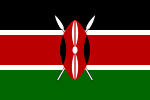This article's tone or style may not reflect the encyclopedic tone used on Wikipedia. (April 2023) |
Kipsigiis, Kipsikiis | |
|---|---|
| Regions with significant populations | |
| Kenya | 1,905,983[1] |
| Languages | |
| Kipsigis, Swahili and English | |
| Religion | |
| Asisian Religion, Christianity, Islam, Atheism | |
| Related ethnic groups | |
| Kalenjin people: Nandi, Tugen, Marakwet, Sengwer, Sebei, Pokot, Terik | |
| Part of a series on the |
| Culture of Kenya |
|---|
 |
| Cuisine |
The Kipsigis or Kipsigiis[2] are a Nilotic group contingent of the Kalenjin ethnic group and speak a dialect of the Kalenjin language identified by their community eponym, Kipsigis.[3] It is observed that the Kipsigis and another aboriginal group native to Kenya known as Ogiek have a merged identity. The Kipsigis are the biggest sub tribe within the Kalenjin community. The latest census population in Kenya put the Kipsigis at 1,972,000 speakers, accounting for 45% of all Kalenjin speaking people. They occupy the highlands of Kericho stretching from Timboroa to the Mara River in the south and the Mau Escarpment in the east to Kebeneti. They also occupy parts of Laikipia, Kitale, Nakuru, Narok, the Trans Mara District, Eldoret and the Nandi Hills.
Apart from the Kalenjin, the other tribe is the Tatonga of Western Tanzania. In their expansion southwards, the Kipsigis and the Tatonga people reached the present-day Shinyanga area in Western Tanzania only for the former group to return to the Kericho area before some went back south, but could only settle at Angata Barigoi in Trans Mara next to the Tanzanian Border.
The IBEAC company and the British colonial government referred to the Kipsigis people as Lumbwa and Kwavi.[4] The pre-colonial traditional occupations of the Kipsigis included semi-pastoral herding, military expeditions, and farming sorghum and millet. Post-colonial Kipsigis today still live predominantly in their historical tribal territory on the Western Highlands of Kenya at an altitude of 1500m to 2000m; they mainly grow tea, undertake dairy farming and farm maize. They also grow wheat, pyrethrum and coffee.[5]
- ^ "2019 Kenya Population and Housing Census Volume IV: Distribution of Population by Socio-Economic Characteristics". Kenya National Bureau of Statistics. Archived from the original on 5 June 2020. Retrieved 24 March 2020.
- ^ Fish, Burnette C. (1995). The Kalenjiin heritage : traditional religious and social practices. Africa Gospel Church. p. 376. ISBN 0-9620406-6-5. OCLC 40199906.
- ^ Toweett, Taaitta (1979). A study of Kalenjin linguistics. Nairobi: Kenya Literature Bureau. OCLC 987969784. Archived from the original on 23 April 2022. Retrieved 23 April 2022.
- ^ Great Britain. Admiralty. (1920). A handbook of Kenya Colony (British East Africa) and the Kenya Protectorate (protectorate of Zanzibar). H.M. Stationery Office. OCLC 47709266.
- ^ "The Kipsigis". African Latitude Safari. Archived from the original on 15 December 2013. Retrieved 15 December 2013.
